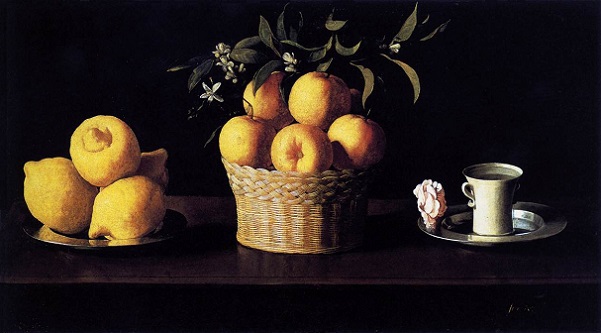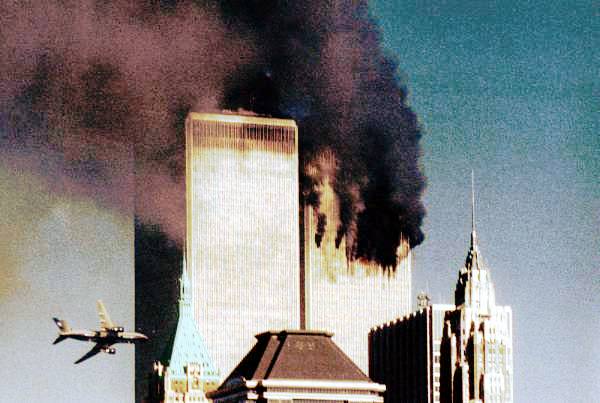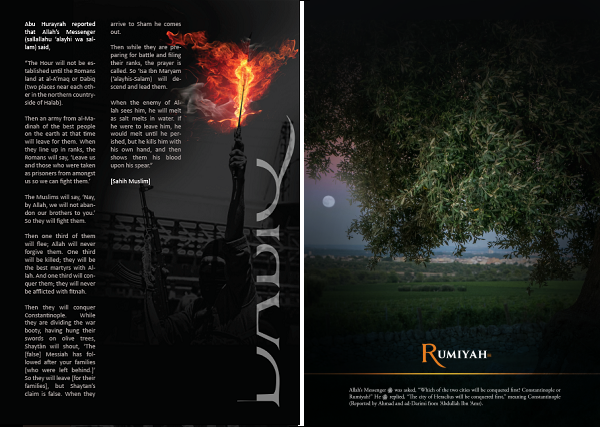The Republic of Bloggers, SpiralChris & Pundita
Tuesday, September 13th, 2016[ by Charles Cameron — on music, art, and the double meanings of fruit, bread, wine ]
.
Still-life with Lemons, Oranges and Rose, Francisco de Zurbarán, Norton Simon Museum, Pasadena
**
Chris Bateman, aka SpiralChris, responded a couple of weeks ago to my own open letter to him, beginning:
Dear Charles,
The second of my five religions, Zen Buddhism, came about entirely as a consequence of a famous tale you allude to in your wonderful letter.
After quickly rocounting the tale in question — about the Zen patriarch Hui Neng and the “finger pointing at the moon” which should not be mistaken for the moon itself, he went on:
I spent a great deal of time that night meditating upon the gloriously full moon, a little about my finger, and a great deal about the space in between. Space. The space between. The space beyond. When I could be any or all of these, I went to bed. I thought to myself: How arbitrary it is that we should see ourselves as the finger, and as not-the-moon, when we might just as well consider ourselves the spaces in between – since without that, we could never be not-anything!
This lunar encounter served me well until about five years later I hit a terrifying crisis of identity when I lost faith in any ability to use words to communicate at all. I began to fray at the edges… If everyone’s words were their own symbols, how could we ever manage to communicate? Did we? Or were we just braying at each other at random, each one watching a different play on the stage we had been thrown together upon?
**
That phrase “the spaces in between” is particularly interesting when you think of it as referencing the space between word and what it refers to, the word “moon” and the up-there orb, the moon. You might think, “there’s no such space between, they’re in different realms, is all” — but there is a between, it’s the relationship. And that’s what all my HipBone & DoubleQuote Games are about — the relationship (mapped along a linking line, aka an “edge”) between two concepts (“nodes”). Because relationship is the essence of their antecedent, Hesse‘s Glass Bead Game. And of all relationships, perhaps those between name and thing, finger and moon, map and territory, moon and enlightenment, are among the most fascinating.
Consider, though, the relationship between person (genetically understood) and person (memetically understood), as in the case of persons of genius or great charisma.
Hermann Hesse played the Glass Bead Game himself, he tells us, in his garden, while raking leaves into the fire, and it consisted of figures he admired, talking across th4 centuries — “I see wise men and poets and scholars and artists harmoniously building the hundred-gated cathedral of the mind.” In his book, the Game does not consist of these people, but of their ideas — disembodied, if you will.
The genetics / memetics difference shows up elsewhere in intriguing ways. Should Peter, the closest disciple, lead the church after Christ‘s death, or James, his blood brother? — that’s the Jerusalem vs Rome controversy that plays out in the background to the New Testament. Should his followers follow Brigham Young, his closest disciple, after Joseph Smith‘s death. or a family member? When Kabir, the poet-saint of India died, his Hindu followers wanted to cremate his remains, his Muslim followers to bury him — when they uncovered his body, they found (so the tale is told) that it had turned to roses, and were thus able to divide his remains and perform both ceremonies.
Family has a claim to the person, discipleship has a claim to the inspiration. Funny, that.
**
Chris was responding to me as part of what he happily terms The Republic of Bloggers:
During the Enlightenment at the end of the 17th century and the start of the 18th, a disparate group of intellectuals in Europe and the United States engaged in a long-distance discourse that became know as the Republic of Letters, or Respublica Literaria. It was one of the first transnational movements, and scholars have endlessly debated its relevance and influence upon the dramatically proclaimed Age of Enlightenment it heralded. Personally, I feel no need to explain this in terms of cause and effect – the Republic of Letters was simply the written discourse of a movement that was changing the way people thought about their relationship with the world.
It is a seldom noticed fact that while anyone who can read and write could write a letter, very few actually do – and fewer still in our current era, what it is tempting to call the Age of Distraction. Letters, rather than say postcards and other friendly waves expressed in writing, involve a kind of engagement that has become rather rare these days. A letter invites a response, asks us to think about something, requests insight from another perspective… Letters are conversations at a slow enough pace to allow the correspondents to think a out what they are saying. I would like to suggest that it takes a particular kind of introvert to engage in letter writing in this sense – a quiet soul not content to bury themselves in just their solitary activities, but willing and able to reach out in words to another, similar person. I love a good conversation in a pub or bar, or at a conference, or even on a long journey, but as enjoyable as these forms of discourse may be for me they cannot adequately substitute for the pleasure of the letter.
For Chris, blog posts are the current equivaoent of letters, and what he terms The Republic of Bloggers is a latter day equivalent of the Republic of Letters of yore.
It is similar in spirit to Col. Pat Lang‘s Committee of Correspondence, Sic Semper Tyrannis, except that there all the correspondents correspond on the one blog.
The Republic of Letters is a concept I very much appreciate, and I have tried to embody it both here and in my time at the Skoll Foundation’s Social Edge platform a decade ago.
**
At which point, I must introduce blog-friend Pundita, sometimes known as the Julia Childs of Foreign Policy discussion. She and I have been going back and forth on the topic of sacred music — qawwali, gospel, and so forth.
Recently, Pundita, in a post of August 31st titled O Magnum Mysterium: Why has Christianity declined so much in a land that produces the greatest Christian choirs?, responds in part to my having alerted her to Morten Lauriden‘s gloriously beautiful rendering of the Catholic chant, O Magnum Mysterium:
Look at the still-life at the top of this post. What do you see? If you tell me you see the Virgin Mary and the Mystery of her giving birth to the Christ, either you are already familiar with the painting, made famous in this era by Morton Lauridsen’s explanation of how it inspired his version of O Magnum Mysterium. Or you are steeped in the symbolism of the High Church and/or the use of Christian symbols in art.
I’m sorry but the symbolism is so abstract that those are the only ways to read Mary and the Virgin Birth into a painting of fruit, a flower, and a cup of water, although I’ll concede the symbolism could have been understood by well-educated Christians centuries ago in Europe.
Lauridsen himself did not understand the symbolism of the painting when he first saw it — a point he does not make clear to readers in his 2009 article for The Wall Street Journal about the painting It’s a Still Life That Runs Deep, and its role in inspiring his version of OMM.
That post was in response to something I’d sent her, recommending Lauridsen’s work. More “Republic of Bloggers” style communication!
**
Chance reading the other day brought me to Jacob Mikanowski‘s piece, Camera-phone Lucida, in which i found:
The first society to experience the problem of having too much money and too much stuff, the Dutch had multiple genres of food-related still lifes, each dealing in a different level of luxury. They began with the humble ontbijtjes, or breakfast paintings, to the slightly more elaborate banketjestukken or “little banquets,” and on to the kings of them all, the pronkstilleven, from the Dutch word for “ostentatious.” The “little breakfasts” were the domain of simple food: a plate of herrings, a freshly baked bun, a few olives, maybe a peeled lemon for a bit of color. The atmosphere in these canvases is orderly and Calvinist. By contrast, in the pronkstilleven, the prevailing mood is one of jubilant disorder. Lobsters perch precariously on silver trays. Tables are strewn with plates of oysters, overturned tankards, baskets spilling over with fruit, scattered nuts and decorative cups. Cavernous mincemeat pies jostle with lutes and the occasional monkey.
For a century scholars have sought a deeper meaning in these and other still lifes. A half-eaten cheese stood for the transubstantiated body of Christ; walnuts represented him on the cross — the meat of the nut was his flesh, the hard shell was the wood of the cross he died on.
And so — inside or outside th Republic of Bloggers — the conversation flows..
**
And if Morten Lauridsen can wring such beauty from a reading of symbolism in Zurbarán, let him do so!
Walter & Lady Tramaine Hawkins, Goin’ up yonder:
Nusrat Fateh Ali Khan, Allah Hoo:
Morten Lauridsen, O Magnum Mysterium:
Morten Lauridsen, It’s a Still Life That Runs Deep






